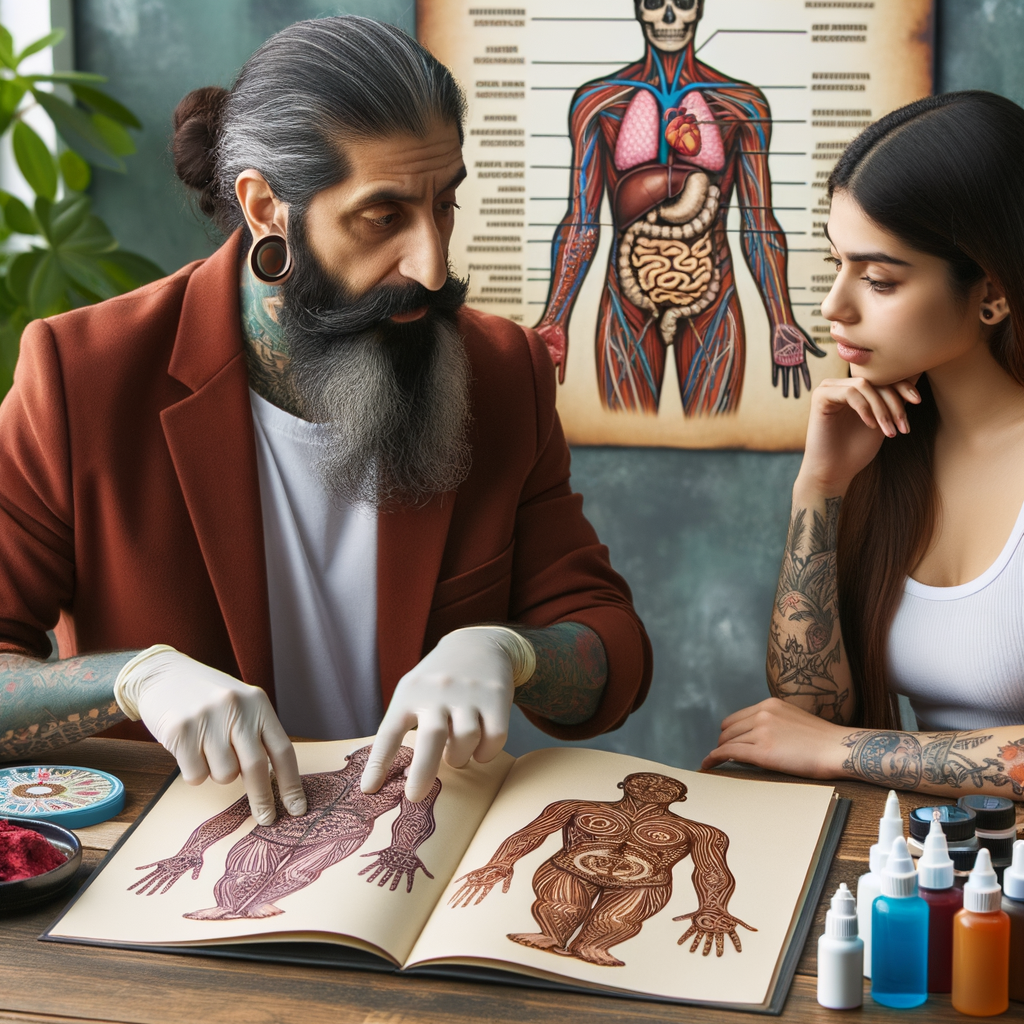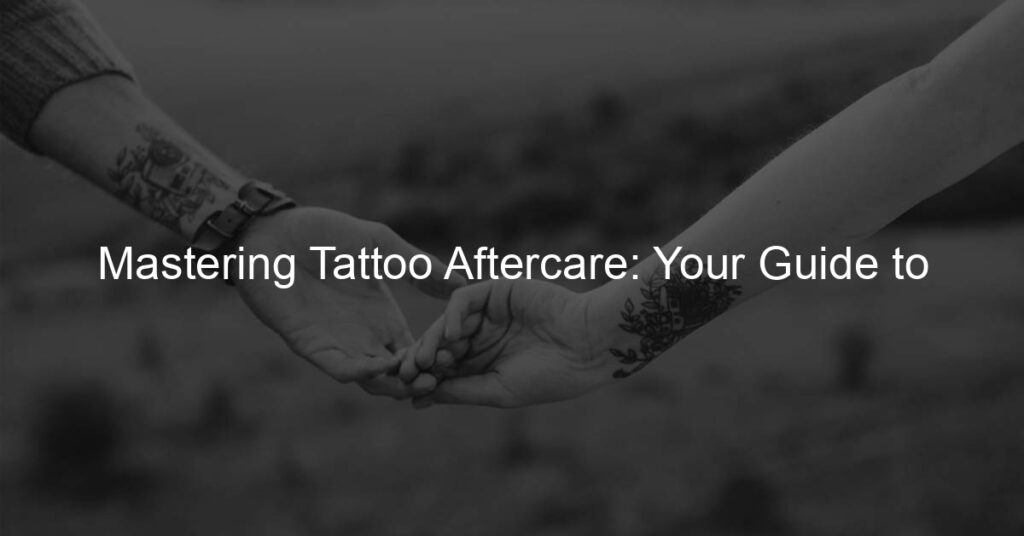
Introduction to Tattoo Healing Process
When you get a tattoo, it’s not just about choosing the perfect design or finding the right artist. It’s also about taking care of your new piece of body art. This is where the tattoo healing process comes into play. Understanding this process is crucial to maintaining the vibrancy and longevity of your tattoo.
- Understanding the Importance of Tattoo Healing
Why is the tattoo healing process so important? Well, a tattoo is essentially a wound on your skin. The needle used by the tattoo artist punctures your skin, depositing ink into the second layer of skin known as the dermis. This process causes a certain level of skin damage.
Just like any other wound, your body needs time to heal. If you don’t take proper care of your tattoo during this healing process, it can lead to infection, color fading, and even scarring. Therefore, understanding and following the tattoo healing process is essential for the health of your skin and the look of your tattoo.
- Overview of the Tattoo Healing Stages
The tattoo healing process is not a one-day event. It happens in stages and can take anywhere from two weeks to a month, depending on your body’s healing ability and how well you care for your tattoo.
The first stage is known as the open wound stage. This is when your tattoo is fresh, and your skin is open and raw. You might experience some redness, swelling, and even a little bleeding.
The second stage is the peeling stage. Your skin will start to regenerate, and you’ll notice some peeling and flaking. It’s important not to pick or scratch at your tattoo during this stage.
The final stage is the healing stage. This is when your skin fully heals and the tattoo settles into the dermis. Your tattoo will start to look more vibrant and clear.
Remember, each person’s healing process can be different. What’s most important is to listen to your body and take good care of your tattoo.
Perfect Tattoo Care: The Basics
Getting a new tattoo is an exciting experience, but it’s also a big responsibility. It’s important to take proper care of your tattoo to ensure it heals properly and looks its best. Here are some basic tips for perfect tattoo care.
Initial Tattoo Recovery Tips
After getting a new tattoo, the first few days are crucial for its recovery. Here are some tips to help you through this initial stage.
-
- How to clean a new tattoo
Cleaning your new tattoo is an essential step in the healing process. Here’s a simple guide:
-
-
- Wash your hands thoroughly before touching your tattoo.
- Use a mild, unscented soap to gently clean the tattooed area.
- Pat the area dry with a clean towel. Don’t rub it as it can irritate the skin.
- Apply a thin layer of tattoo aftercare ointment. Don’t overdo it as too much ointment can suffocate the skin and delay healing.
- Protecting your tattoo from external factors
-
Your new tattoo is like an open wound, and it’s vulnerable to bacteria and other external factors that can cause infection. Here’s how to protect it:
-
- Avoid swimming in pools, hot tubs, or open water to prevent exposure to bacteria.
- Keep your tattoo covered with a clean bandage for the first few hours.
- Avoid direct sunlight as it can fade the tattoo and slow down the healing process.
- Don’t scratch or pick at the tattoo, even if it itches. This can lead to scarring and infection.
Long-term Tattoo Care Instructions
After your tattoo has healed, it’s essential to continue taking care of it to maintain its vibrancy and clarity. Here are some long-term care instructions to help you keep your tattoo looking fresh and vibrant for years to come.
- Moisturizing your tattooJust like your skin, tattoos need to be moisturized regularly to maintain their vibrancy. Dry skin can make your tattoo look dull and faded. Use a gentle, fragrance-free moisturizer to keep your tattooed skin soft and hydrated. Apply the moisturizer gently, without rubbing too hard, to avoid irritating the skin. Remember, a well-moisturized tattoo is a happy tattoo!
- Avoiding sun exposureThe sun’s UV rays can be harmful to your tattoo. Over time, prolonged exposure to the sun can cause your tattoo to fade and lose its original colors. When going out in the sun, make sure to cover your tattoo with clothing or use a high SPF sunscreen specifically designed for tattoos. It’s best to avoid sunbathing or tanning beds as these can accelerate the fading process.
- When to seek professional helpWhile it’s normal for a tattoo to peel and itch during the healing process, any signs of infection such as excessive redness, swelling, or pus should be a cause for concern. If you notice any of these symptoms or if your tattoo isn’t healing as expected, it’s important to seek professional help immediately. A professional tattoo artist or a dermatologist can provide the necessary advice and treatment to prevent further complications.
Remember, taking care of your tattoo is a long-term commitment. By following these instructions, you can ensure that your tattoo remains vibrant and beautiful for many years to come.
Healing a New Tattoo: The Do’s and Don’ts
When it comes to healing a new tattoo, there are certain things you should do and some things you should avoid. Let’s break it down into the do’s and don’ts of tattoo aftercare.
- Do’s of Tattoo Aftercare
Here are some important steps you should follow after getting a tattoo:
- Keep it Clean: Always clean your tattoo with mild, unscented soap and warm water. This helps to prevent infection.
- Moisturize: Use a tattoo-specific moisturizer to keep your skin hydrated and help your tattoo heal properly.
- Protect from Sunlight: Sunlight can fade your tattoo and slow down the healing process. It’s best to keep your tattoo covered when you’re outside.
- Follow Your Artist’s Advice: Your tattoo artist knows best. Follow their aftercare instructions to the letter.
- Don’ts of Tattoo Aftercare
Here are some things you should avoid doing after getting a tattoo:
- Don’t Scratch or Pick: It’s normal for a new tattoo to itch, but scratching or picking can cause scarring and infection.
- Don’t Soak: Avoid soaking your tattoo in water, like in a bath or swimming pool, until it’s fully healed.
- Don’t Expose to Direct Sunlight: As mentioned earlier, direct sunlight can damage your tattoo. Always keep it covered or use a high SPF sunscreen.
- Don’t Ignore Signs of Infection: If you notice any signs of infection, like redness, swelling, or pus, contact a healthcare professional immediately.
Remember, tattoo aftercare is just as important as the tattooing process itself. By following these do’s and don’ts, you can ensure your tattoo heals properly and looks its best for years to come.
Understanding Tattoo Healing Stages
Getting a tattoo is an exciting experience, but it’s also a process that requires understanding and care. One of the most important parts of this process is the healing stage. Let’s dive into the first stage of tattoo healing: oozing and redness.
Stage 1: Oozing and Redness
After your tattoo session, you’ll enter the first stage of healing. This is characterized by oozing and redness around your new tattoo.
-
- What to expect:
During this stage, your tattoo will start to ooze a mixture of blood, plasma, and ink. This is completely normal and is a sign that your body is starting to heal. Along with this, you may notice some redness and swelling. This is due to the trauma your skin has undergone during the tattoo process.
-
- How to manage:
Managing this stage is all about keeping the area clean and avoiding irritation. Gently clean the area with warm water and mild soap, then pat it dry. Avoid rubbing or scratching the tattoo, even if it feels itchy. It’s also important to keep the tattoo out of direct sunlight and avoid submerging it in water, such as in a pool or bathtub.
Remember, everyone’s body heals at different rates, so don’t be alarmed if your tattoo takes a little longer to move past this stage. The key is to be patient and take care of your new ink.
Stage 2: Itching and Flaking
After the initial stage of oozing and redness, your tattoo will enter the second stage of healing. This stage is characterized by itching and flaking. Let’s delve into what to expect and how to manage this stage.
-
- What to expect:
During this stage, your skin will start to dry out and peel, similar to a sunburn. This is a normal part of the healing process. The itching can be intense, but it’s crucial not to scratch your tattoo. Scratching can damage the tattoo and lead to infection.
-
- How to manage:
Managing the itching and flaking stage requires patience and care. Here are some tips:
-
- Moisturize: Use a gentle, fragrance-free lotion to keep your skin hydrated. This can help reduce itching.
- Avoid scratching: No matter how much it itches, don’t scratch! Scratching can damage your tattoo and lead to infection.
- Stay hydrated: Drinking plenty of water can help your skin heal faster.
- Wear loose clothing: Tight clothing can irritate your tattoo and make the itching worse. Opt for loose, breathable fabrics instead.
Remember, everyone’s body heals at a different rate. If you’re concerned about your tattoo’s healing process, don’t hesitate to reach out to a healthcare professional or your tattoo artist.
Stage 3: The Final Healing
The final stage of the tattoo healing process is a critical one. It’s when your skin fully recovers and the tattoo’s colors and details become vivid and clear. Let’s delve into what to expect during this stage and how to manage it effectively.
-
- What to expect
At this stage, your tattoo should no longer be a source of discomfort. The redness, swelling, and itching from the previous stages should have subsided. Your skin might still be slightly sensitive to the touch, but it should feel more or less like the rest of your skin.
The colors of your tattoo will have settled into their final shades. If your tattoo artist used high-quality ink, the colors should be vibrant and clear. However, this can vary depending on the type of ink used and your skin’s reaction to it.
-
- How to manage
Even though your tattoo might look and feel healed, it’s important to continue with your aftercare routine. Keep the area clean and moisturized. Avoid exposing the tattoo to direct sunlight, as this can cause the colors to fade. If you must go out in the sun, make sure to apply a high SPF sunscreen to protect your tattoo.
Remember, the final healing stage is crucial for the longevity of your tattoo. If you neglect your aftercare routine now, it could lead to complications later on. So, continue to treat your tattoo with care and respect it deserves.
In conclusion, the final healing stage is a critical phase in the tattoo healing process. By knowing what to expect and how to manage it, you can ensure that your tattoo heals properly and looks its best for years to come.
Tattoo Aftercare Products: What to Use
After getting a tattoo, it’s important to take good care of it. This will help your tattoo heal properly and look its best. There are many products available that can help with this process. In this section, we will discuss the best moisturizers and sunscreens for tattoo aftercare.
-
- Best moisturizers for tattoo aftercare
Keeping your new tattoo moisturized is crucial for its healing and longevity. The skin can become dry and itchy after getting a tattoo, and a good moisturizer can help alleviate these symptoms. Here are some recommended moisturizers for tattoo aftercare:
-
-
- Aquaphor Healing Ointment: This is a popular choice among tattoo artists. It’s fragrance-free, which is great for sensitive skin, and it helps to hydrate and soothe the skin.
- Lubriderm Daily Moisture Lotion: This is another good option. It’s lightweight and non-greasy, making it comfortable to wear throughout the day.
- Recommended sunscreens for tattoo protection
-
Protecting your tattoo from the sun is also very important. Sun exposure can fade the colors of your tattoo and damage the skin. Here are some recommended sunscreens for tattoo protection:
-
- Neutrogena Ultra Sheer Dry-Touch Sunscreen: This sunscreen is water-resistant and has a high SPF, making it a great choice for protecting your tattoo.
- Coppertone Tattoo Guard Lotion: This sunscreen is specifically designed for tattoos. It helps to prevent fading and keeps your tattoo looking vibrant.
Remember, taking care of your tattoo doesn’t stop after it heals. Regular moisturizing and sun protection will help keep your tattoo looking fresh and vibrant for years to come.
Tattoo Recovery Timeline: What to Expect
Understanding the tattoo recovery timeline is crucial for ensuring your new ink heals properly and looks its best. Here’s what you can expect during the first month of tattoo recovery.
- First Week of Tattoo RecoveryIn the first week after getting your tattoo, your skin will start the healing process. You might notice some redness, swelling, and a little bit of bleeding. This is normal and part of your body’s natural response to the tattooing process. It’s important to keep the area clean and moisturized during this time. Avoid scratching or picking at the tattoo, as this can lead to infection or damage to the design.
- Second Week of Tattoo RecoveryDuring the second week, your tattoo will start to peel, similar to a sunburn. This is a sign that your skin is continuing to heal. Continue to keep the area clean and apply a thin layer of moisturizer as needed. Avoid swimming or soaking the tattoo in water, as this can slow down the healing process.
- One Month After Getting a TattooBy the end of the first month, your tattoo should be fully healed on the surface. The skin might still feel a bit sensitive, and the colors of your tattoo may not be as vibrant as they will be once fully healed. It’s still important to keep the area moisturized and protected from the sun to ensure the best possible healing outcome.
Remember, everyone’s body heals at a different rate, so your tattoo recovery timeline might be slightly different. Always follow the aftercare instructions provided by your tattoo artist, and don’t hesitate to reach out to them if you have any concerns about your healing process.
| Week | What to Expect | Do’s | Don’ts |
|---|---|---|---|
| 1 | Redness, swelling, slight bleeding | Keep clean, moisturize | Avoid scratching, picking |
| 2 | Peeling | Continue cleaning, moisturizing | Avoid swimming, soaking |
| 1 month | Surface healing complete, colors may not be vibrant | Keep moisturized, protect from sun | Don’t neglect aftercare |
Case Study: Successful Tattoo Healing
Let’s delve into a real-life example of successful tattoo healing. This case study will provide you with a clear understanding of the process and the steps involved in ensuring a smooth and successful tattoo healing journey.
-
- Overview of the case
Our case involves a 28-year-old woman named Lisa who recently got her first tattoo. Lisa was very excited about her new tattoo, a beautiful butterfly on her shoulder. However, she was also aware that the healing process was crucial to maintain the vibrancy and longevity of her tattoo.
-
- Steps taken for successful healing
Lisa followed a comprehensive tattoo aftercare routine to ensure successful healing. Here are the steps she took:
-
-
- Cleaning: Lisa cleaned her tattoo gently with lukewarm water and a mild, fragrance-free soap, as recommended by her tattoo artist. She did this twice a day to keep the area clean and free from infection.
- Moisturizing: After cleaning, she applied a thin layer of a specialized tattoo healing ointment. This helped to keep the tattooed skin hydrated and promoted healing.
- Protection: Lisa made sure to protect her tattoo from direct sunlight and avoided swimming to prevent fading and infection.
- Healthy lifestyle: She maintained a healthy lifestyle by eating a balanced diet and staying hydrated. This boosted her immune system and aided in faster healing.
-
By following these steps, Lisa was able to successfully heal her tattoo within two weeks, without any complications. Her tattoo remains vibrant and clear, a testament to her diligent aftercare routine.
Conclusion: Mastering Your Tattoo Aftercare
As we reach the end of our journey through the world of tattoo aftercare, it’s time to summarize the key takeaways and reflect on the importance of this process. Ensuring your tattoo heals properly and maintains its vibrant colors is not a task to be taken lightly. It requires dedication, patience, and a thorough understanding of the process.
-
- Key takeaways for perfect tattoo care
Firstly, remember that the healing process of a tattoo is just as important as the process of getting the tattoo. It’s crucial to follow the aftercare instructions provided by your tattoo artist. This includes keeping the tattoo clean, moisturizing it regularly, and avoiding sun exposure and swimming.
Secondly, understand that every tattoo goes through different healing stages. Each stage requires a different type of care. For instance, during the first stage, it’s essential to keep the tattoo clean to avoid infection. In the later stages, moisturizing becomes more important to prevent scabbing and color loss.
Lastly, always use the recommended aftercare products. These products are designed to aid the healing process and ensure the longevity of your tattoo. Avoid using products that are not specifically designed for tattoo aftercare as they can cause damage to your skin and your tattoo.
-
- Final thoughts on the importance of tattoo aftercare
Tattoo aftercare is not just about preserving the aesthetic appeal of your tattoo. It’s also about protecting your health. A poorly cared-for tattoo can lead to infections and other health complications. Therefore, taking the time to properly care for your tattoo is not just an investment in your appearance, but also in your well-being.
Remember, a tattoo is a lifelong commitment. It’s a piece of art that becomes a part of you. Therefore, it deserves the best care possible. By mastering your tattoo aftercare, you ensure that your tattoo remains vibrant and beautiful for years to come.






